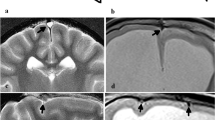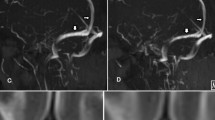Abstract
Data concerning venous anatomy, interstitial fluid pressure and cerebral blood flow indicate that obstruction of cerebral venous outflow (as a whole or involving the deep venous system alone) is the essential cause of hydrocephalus. Choroidal and ventricular veins both belong to the deep system. Choroidal venous pressure determines cerebrospinal fluid pressure; pressure in the ventricular veins determines interstitial fluid pressure in the paraventricular white matter. A decrease in deep cerebral blood flow causes paraventricular atrophy. CSFP is higher than interstitial fluid pressure, normally and in venous obstruction. Thus, CSFP prevents venocongestive edema (but not inflammatory edema) of the brain. Collateral venous pathways are described. Venous obstruction causes hydrocephalus only when it leads to insufficient blood flow. Cerebrospinal fluid shunting causes increased CBF as essential therapeutic effect in hydrocephalus, but also causes venocongestive brain edema, which explains the decrease in ventricle size and the side effects of shunting.
Similar content being viewed by others
References
Adachi C, Mihara H, Matsuo O (1974) Fluid pressure of capsules implanted into dog brain. Jpn J Physiol 24:45–58
Andeweg J (1976) The cause of hydrocephalus. Bronder, Rotterdam
Andeweg J (1986) Venous resistance: the cause of hydrocephalus. J Pediatr Neurosci 2:153–173
Batson OV (1944) Anatomical problems concerned in the study of cerebral blood flow. Fed Proc 3:139–144
Batson OV (1957) The vertebral vein system. AJR 78:195–212
Bedford THB (1934) The great vein of Galen and the syndrome of increased intracranial pressure. Brain 57:1–24
Bedford THB (1934) The venous system of the velum interpositum of the rhesus monkey and the effect of experimental occlusion of the great vein of Galen. Brain 57:255–265
Bell BA (1983) A history of the study of cerebral edema. Neurosurgery 13:724–728
Bering EA, Salibi B (1959) Production of hydrocephalus by increased cephalic-venous pressure. Arch Neurol Psychiatry 81:693–698
Duret H (1874) Recherches anatomiques sur la circulation de l'encéphale. Arch Physiol Norm Pathol 6:316–353
Duvernoy HM (1975) The superficial veins of the human brain — veins of the brain stem and of the base of the brain. Springer, Berlin Heidelberg New York
Ferner H (1958) Anatomische und phlebographische Studien der inneren Hirnvenen des Menschen. Z Anat Entwicklungsgesch 120:481–491
Gius JA, Grier DH (1950) Venous adaptation following bilateral radical neck dissection with excision of the jugular veins. Surgery 28:305–321
Gowin W (1983) Die Bedeutung des Wirbelsäulenvenensystems bei der Metastasenbildung. Strahlentherapie 159:682–689
Hédon E (1888) Étude anatomique sur la circulation veineuse de l'encéphale. Bellier, Bordeaux
Higashi K, Asahisa H, Ueda N, Kobayashi K, Hara K, Noda Y (1986) Cerebral blood flow and metabolism in experimental hydrocephalus. Neurol Res 8:169–176
Oi S, Matsumoto S (1985) Slit ventricles as a cause of isolated ventricles after shunting. Child's Nerv Syst 1:189–193
Pöll W, Brock M, Markakis E, Winkelmüller W, Dietz H (1972) Brain tissue pressure. In: Brock M, Dietz H (eds) Intracranial pressure. Springer, Berlin Heidelberg New York, pp 188–194
Schlesinger B (1939) The venous drainage of the brain, with special reference to the Galenic system. Brain 62:274–291
Author information
Authors and Affiliations
Rights and permissions
About this article
Cite this article
Andeweg, J. Intracranial venous pressures, hydrocephalus and effects of cerebrospinal fluid shunts. Child's Nerv Syst 5, 318–323 (1989). https://doi.org/10.1007/BF00274522
Received:
Issue Date:
DOI: https://doi.org/10.1007/BF00274522




